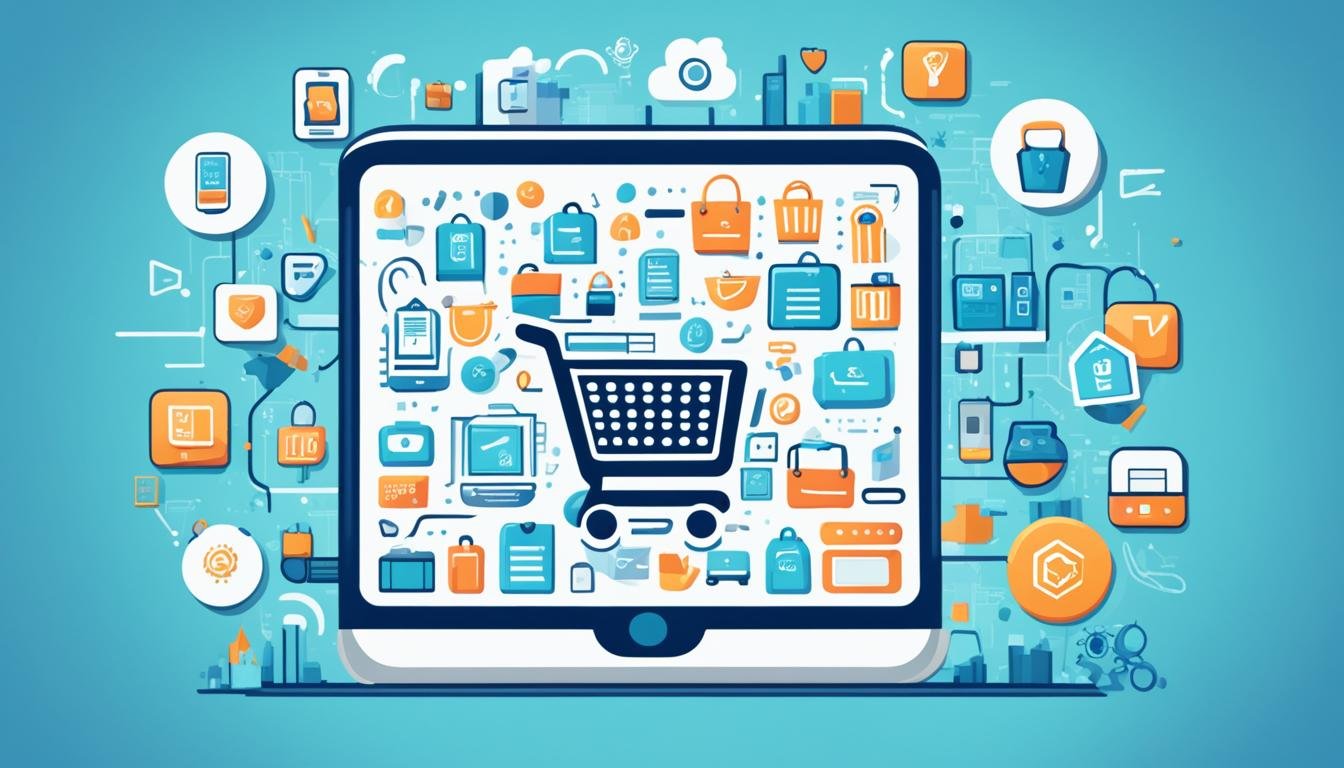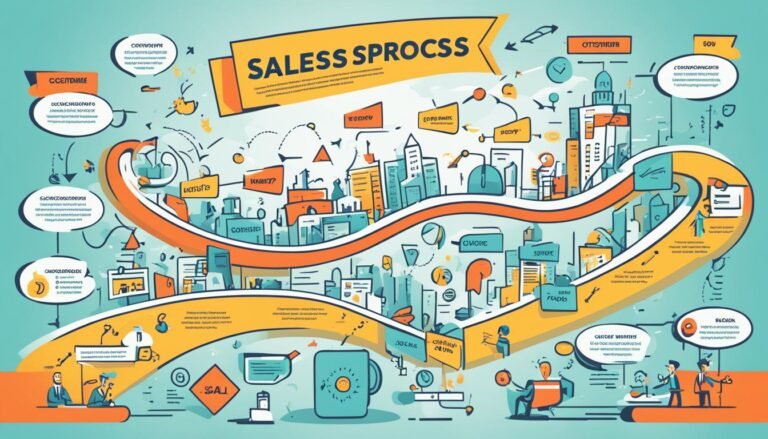The M-commerce Revolution: How Mobile-First Design is Driving Online Sales
Ever thought about how m-commerce is changing online shopping? And why mobile-first design is key for online business growth? With smartphones in our pockets, mobile shopping is booming. In 2020, m-commerce hit a huge $2.91 trillion in sales worldwide, making up over 67.2% of all e-commerce transactions.
Businesses must keep up with e-commerce trends and make their sites mobile-friendly. Since most people own smartphones, and mobile internet traffic is almost 60% of all online activity, companies like Amazon, Starbucks, and Nike lead with mobile-first strategies.
So, what’s behind this mobile shopping boom? How do companies use mobile-first design to keep customers coming back? And why is this key for ongoing online business growth?
Key Takeaways
- M-commerce’s share in global e-commerce sales illustrates its rising significance.
- Increasing smartphone penetration and mobile internet usage fuel the growth of mobile shopping.
- Effective mobile-first design strategies are critical for business success.
- Advancements in mobile technology and faster internet speeds enhance the user experience.
- Optimization of e-commerce platforms for mobile devices focuses on responsive design, fast loading times, and streamlined checkout processes.
Introduction to Mobile Commerce
Mobile commerce, or m-commerce, is about buying and selling through mobile devices. It’s growing fast and taking a big part of the e-commerce market.
Definition and Importance
Mobile commerce means doing transactions on smartphones and tablets. It’s big because more people use mobile tech and are tech-savvy. M-commerce makes shopping easy by letting users shop anywhere, compare prices fast, and get personalized deals.
This ease of access has changed how people shop around the world. It has made the m-commerce market grow a lot.
Market Size and Potential
About half of all online shopping is done on mobile devices. By 2024, there will be 187.5 million mobile shoppers. This shows the m-commerce market could hit $4.5 trillion, making up 69.9% of all online sales.
Mobile payments are getting more popular, and social media is affecting what people buy. This shows how big the m-commerce market could get.
Personalized shopping on mobile can make customers more engaged by 70%. It can also increase sales by 5-8%. Companies that use mobile well see a 23% increase in customer happiness and keep more customers.
Growth of Mobile Commerce
Mobile commerce is changing the way we shop online. With more people using smartphones, better mobile payment systems, and new shopping experiences, m-commerce is changing how we shop. eMarketer says 67% of people worldwide owned a mobile phone in 2019. This led to a big increase in mobile shopping.
Global Trends
Now, 65% of all online shopping traffic comes from mobile devices, while desktop use is down to over 27%. This change is because mobile shopping is easy and convenient. In 2019, over 42% of retail sales happened on mobile devices, showing more people prefer m-commerce.
Experts predict mobile commerce sales will hit $2.91 trillion in 2021, up 25.4% from 2019. These numbers show how fast mobile commerce is growing.
Key Drivers of Growth
Several things are pushing mobile commerce up. First, mobile payment systems like Alipay and WeChat Pay make buying things online safer and easier. Second, people spend almost 90% of their mobile time on apps, showing they like shopping on apps more than websites.
This has led to a 20% increase in mobile app downloads for shopping in 2020. Also, 76% of people shop on mobile to save time, and 70% of mobile searches lead to buying something within an hour. These facts show how mobile shopping is becoming a big part of our lives.
The move to mobile-first shopping is changing retail and making m-commerce grow fast. As people keep choosing mobile for its ease and speed, businesses have big chances to innovate and grow in this changing market.
Main Challenges in Mobile Commerce
Mobile commerce has big promises but also faces many challenges. These issues are key to keeping trust, ensuring compatibility, and improving performance. They are crucial for staying competitive and keeping customers loyal. Let’s look at the main challenges:
Security and Privacy Issues
M-commerce security is a big worry for both companies and shoppers. With sales hitting $2.91 trillion in 2020, it’s a prime target for hackers. Using strong security and following rules like GDPR and PCI DSS is key to keeping customer privacy online safe. Innovating in this area helps brands gain trust, which is vital today.
Also, mobile payments are growing fast, expected to hit $4.6 trillion by 2025. This means businesses must keep up with threats to keep customer data safe and transactions secure.
User Experience and Design Challenges
Creating a smooth mobile user experience is tough in mobile commerce. With people spending most of their shopping time on mobile apps, designs must be responsive and easy to use. Making experiences work well on different devices and screens is key to meeting customer needs and keeping them engaged.
Conversion rates show the importance of good design and features. Mobile apps have a 27% conversion rate, while mobile websites have 10%, and desktop websites have 13%. Making things faster, easier to navigate, and more personalized can greatly improve the mobile experience. This can lead to higher retention rates and more sales.
As companies face these challenges, focusing on m-commerce security and creative design can help. This can lead to a successful and lasting mobile commerce strategy.
Key Benefits of Mobile-First Design
Today, making your website mobile-friendly is a must for e-commerce success. This approach brings many benefits for businesses wanting to stay ahead online.
Enhanced User Engagement
Putting mobile first greatly boosts online engagement. It makes content work better on phones, grabbing users’ attention. With more people using mobiles to browse, mobile-friendly sites keep users interested, leading to longer visits and fewer people leaving quickly.
Higher Conversion Rates
Apps have a 27% conversion rate, while mobile sites only get 10%. This shows how crucial it is to focus on mobile for better sales. A site that’s easy to use on mobile not only gets more visitors but also turns them into loyal customers.
Improved Customer Loyalty
Going mobile-first also helps keep customers coming back. It offers a shopping experience tailored for mobile, making customers happier. Adding easy mobile payments and smooth navigation builds loyalty, leading to more repeat visits and lasting customer relationships. This is key as mobile shopping made up 72.9% of all online sales in 2021.
Best Practices for Mobile-First Design
Mastering mobile-first design is key for success in m-commerce. It greatly improves user experience and boosts sales.
Responsive Web Design
Responsive web design makes your site work well on any device, from smartphones to desktops. It ensures a smooth experience for everyone. This approach keeps customers engaged and helps your site attract more visitors.
Streamlined Checkout Process
A simple checkout process helps reduce cart abandonment and increase sales. Adding one-click checkout can lead to a 28.5% increase in spending. It cuts down on steps and makes buying things faster and easier.
This makes sure customers can finish their purchases without hassle.
Mobile Payment Integration
Using mobile payments like Apple Pay and Google Wallet makes shopping more convenient and secure. In the US and Canada, 66% of restaurants have adopted this technology. It shows how important mobile payments are becoming.
With better security and ease, customers trust your site more. This leads to more completed purchases.
Examples of Successful M-commerce Strategies
Looking at successful m-commerce strategies gives us great insights. Brands like Amazon, Starbucks, and Nike have used mobile innovation to boost their sales. They show us how to succeed in the online world.
Amazon
Amazon leads in e-commerce innovation with its mobile features. Features like voice shopping, one-click checkout, and AI-driven recommendations make shopping easy and fun. These features show Amazon’s effort to improve the user experience and increase mobile sales.
Starbucks
Starbucks uses its mobile app to increase customer loyalty and make things easier. The app lets customers order and pay easily, showing a great m-commerce strategy. It also offers loyalty rewards and mobile payment options, setting a high standard in the food and beverage industry.
Nike
Nike’s mobile strategy is all about offering a lifestyle experience. The Nike app gives users personalized workout plans, exclusive content, and special product launches. This shows how e-commerce innovation can create a strong bond with customers, increasing loyalty and engagement in the m-commerce world.
Mobile Shopping Apps: The Future of M-commerce
Mobile shopping apps are changing how we shop online. They make buying things easy and fun. The key to this change is a great mobile app shopping experience. This comes from personal touches and smooth operations.
User Interface and Experience
A great user interface is key to a good mobile app shopping experience. With sales expected to hit $2.52 trillion by 2024, apps need to be easy to use and look good. A simple design helps users find what they need fast, making them happier customers.
Push Notifications and Personalization
Personalized push notifications are changing the game in mobile shopping. Studies show that custom tips and offers can make 63% of smartphone users more likely to buy. By using data, apps can send messages that matter, building loyalty and more sales.
Integration with Backend Systems
Working well with backend systems is crucial for mobile shopping apps. This means better handling of stock, orders, and customer service. It lets businesses offer shopping in real-time, important since 91% of users bought something online with their phones recently. Adding AR try-ons and voice shopping with AI is making shopping even more fun and easy.
Importance of Cross-Platform Compatibility
In today’s world, making sure your app works on all devices is key. With most web traffic coming from mobile, focusing on device compatibility is vital. Companies need to reach users on many devices to keep them engaged and give them a smooth shopping experience everywhere.
Using a cross-platform approach helps businesses reach more people. It solves device compatibility issues and keeps customers happy by not leaving anyone out. For instance, making apps and websites for different devices lets users choose what they like best. Some might prefer apps for a better experience, while others like websites for easy access.
Also, good cross-platform mobile development boosts multichannel retailing. Today, shoppers want the same experience on their phone, tablet, or computer. By focusing on cross-platform, retailers can give shoppers a smooth journey across all channels.
Investing in cross-platform mobile development keeps businesses ahead in the digital world. With more people using mobile phones, having strong device compatibility is a must. Apps might cost more to make but offer personalization and special features. Websites, on the other hand, are easy to use and reach more people.
As businesses look to save money and grow, cross-platform is key. It meets current needs and prepares for the future. This way, businesses can keep up with mobile trends and reach more customers. In short, going cross-platform helps businesses grow and make customers happy.
Conclusion
The shift to mobile shopping is changing how we buy things online. Now, more than half of all website visits come from mobile devices. This shows how crucial mobile commerce has become. By using mobile-friendly designs and best practices, companies can keep up with these changes.
Mobile shopping has made customers expect easy use, security, and personal touches. Websites that work well on mobile get more visits and load faster. This means having a mobile-friendly site helps with search rankings and keeps you visible to customers.
The future of online sales will be influenced by new tech like augmented reality (AR), virtual reality (VR), and artificial intelligence (AI). These technologies will change how we shop, making it more engaging and personal. But, ignoring mobile could mean losing out on sales. So, focusing on mobile design is key in today’s market.
As more people use mobile to go online, companies that focus on mobile will lead. By keeping up with trends and what customers want, businesses can fully use m-commerce. This will help them grow and succeed in the fast-changing digital world.
Source Links
- The Rise of Mobile Commerce: Capitalizing on the Mobile Shopping Revolution
- 6 Benefits of mCommerce | Articles | Salesfire
- Mobile Commerce: Key Elements + Future of M-Commerce
- How Mobile Commerce is Transforming Customer Shopping Experience
- Online business models: Mobile Commerce: Mobile Commerce: The New Frontier for Online Business – FasterCapital
- US Mcommerce 2023
- 23 Mobile Commerce Statistics every Retailer Should Know | JMango360
- B2C e commerce: Mobile Commerce Revolution: B2C Strategies for the Smartphone Era – FasterCapital
- Mobile Commerce Revolution: Business Essentials
- What is Mobile Commerce? Benefits & Trends | Blog Miquido
- Mobile-First Strategy in Digital Transformation: Reaching the On-the-Go Customer – Kanoo Elite
- Mobile Commerce Development: Unleashing the Power of mCommerce
- Top 11 Mobile Commerce Trends Shaping 2024
- Mobile Commerce 2024: The Opportunity for US Businesses
- Prepare Your E-Commerce Site for Mobile Commerce Trends
- Exploring Shopee’s Success with Mobile-First Marketing
- Mobile Commerce: The Future of Online Shopping
- The Rise of Mobile Shopping: Ecommerce Trends You Can’t Ignore [Infographic]
- Mobile App vs. Mobile Website: Choosing the Best Solution for Your Business | Attract Group
- The Evolution of E-commerce Platforms for Seamless Online Shopping
- Design aesthetics leading to m-loyalty in mobile commerce
- Mobile-First Web Design: Why It’s Essential for Modern Websites
- Embracing Mobile Commerce And Responsive Design – FasterCapital







